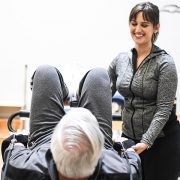Why the Difference between Tendinitis and Tendinosis Matters
Tendinitis and Tendinosis: Why the Difference between them Matters.
Many patients at our specialized physical therapy practice in Portsmouth, NH, suffer from either Tendinitis or Tendinosis. Tendinitis and Tendinosis sound very similar, and are often used interchangeably but they couldn’t be more different. And neither should their treatment regimen.
Tendonitis is an acute, short-term, inflammatory condition typically caused by repetitive overuse of your tendon.
Tendinosis, on the other hand, is a chronic, degenerative condition of your tendon that involves deterioration of collagen, a structural protein in your tendon.
Tendons are tight, yet flexible bands of fibrous tissue that connect your muscle to bone. Without tendons, your muscles would be useless. Tendons are extremely organized, and the fibers are designed in a way to withstand and transmit high forces of tension so your muscle can function properly.
With tendinitis, your tendon becomes inflamed and irritated, typically due to repetitive overuse, and it will hurt when you try to move. The most common areas for tendinitis to occur are your elbows, rotator cuff (shoulder), patella (knee), and Achilles tendon (ankle).
Tendonitis is an acute condition, and the best treatment is to rest, apply ice, and sometimes take anti-inflammatories to control pain. But this should only be for a short period of time. From there, you want to figure out what caused the tendinitis to occur in the first place and address that.
Typically, it’s due to some sort of mismatch between muscle strength and the activity you need to perform, leading your body to compensate and put unwanted stress on your tendon. Once you figure out and correct this pattern, it’s very easy to get rid of your tendinitis.
When you don’t manage tendinitis properly, and it goes on longer than a few months, it can result in tendinosis.
Tendinosis is a very different condition where the fibers in your tendon actually start to break down. An important thing to note is that tendinosis no longer involves inflammation of your tendon. So using ice every day, resting it, and taking anti-inflammatories will not help you, and could even worsen the condition.
Second, since tendinosis involves disorganization and degeneration of the fibers that make up your tendon, you have to “re-organize” those fibers and get blood flowing to the tissue (actually create some inflammation). Unresolved tendinosis leads to progressive weakening of your tendon over time – making it easily susceptible to full blown tears. This is how so many folks tear their Achilles or rotator cuff, for example, “out of nowhere”.
So how do you treat tendinosis and prevent more serious problems from happening down the line?
You have to get blood flow to the area and re-organize those fibers so your tendon can work properly again. Passive treatments like ice, rest, and medicine will not help tendinosis.
The only exception is shockwave therapy (also known as Extracorporeal Pulse Activation Technology).
With shockwave therapy, high-energy sound waves stimulate the body’s natural healing mechanisms by increasing blood flow to the injured, affected area. The increased blood flow delivers oxygen and nutrients to the damaged tissue to help accelerate healing and reduce inflammation.
With pain reduced and the healing process promoted, your tendon is now primed for physical rehabilitation and re-organization of the tendons, the next most essential part of getting rid of your tendinosis.
The only way to truly re-organize tendons is to put stress on them so they can “remodel”. To do this, you have to put just the right amount of stress to cause a little bit of pain (inflammation) – but not so much that your tendon gets inflamed again.
This is literally one of the few times where “no pain no gain” actually holds true. A properly trained physical therapist who is well-versed in tendinosis rehabilitation will know how to do this and can guide you through it.
You have to retrain the fibers in your tendon to withstand normal forces again – and this process takes both time and careful loading strategies.
The good news, however, is that if you rehab your tendinosis properly, you can get back to all the activities you love again as if nothing ever happened. You don’t have to accept this as a chronic condition.
If you’re confused on tendinosis and tendinitis after reading this don’t worry – so is half the medical community.
The take home points to remember are that tendinitis involves pain and inflammation. There is no damage to your tendon, and it only lasts about 4-6 weeks.
Treatment for tendinits should involve passive modalities like ice and rest. The focus should be on what caused your tendon to get irritated in the first place. Then, you can get rid of it before it turns into tendinosis.
If the problem in your tendon has gone on longer than 3 months, you must suspect tendinosis. This no longer involves inflammation but instead, a breakdown of your tendon. Passive treatments (with the exception of shockwave therapy) will not work. They could actually prolong your problem – so stop icing and resting.
To get rid of tendinosis, it requires carefully prescribed loading strategies, aka strengthening. That will properly re-organize your tendon so that it can be strong and functional again. This is extremely challenging to do on your own.
So it’s a good idea to talk to an expert about this. If you are local to and looking for physical therapy in Portsmouth, NH, reach out to schedule a FREE 30 minute discovery session.











